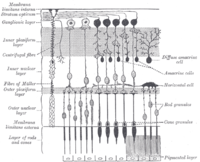
Photo from wikipedia
Circadian rhythms are biological oscillations with a period of about 24 hours. These rhythms are maintained by an innate genetically determined time-keeping system called the circadian clock. A large number… Click to show full abstract
Circadian rhythms are biological oscillations with a period of about 24 hours. These rhythms are maintained by an innate genetically determined time-keeping system called the circadian clock. A large number of the proteins involved in the regulation of this clock are transcription factors controlling rhythmic transcription of so-called clock-controlled genes, which participate in a plethora of physiological functions in the organism. In the brain, several areas, besides the suprachiasmatic nucleus, harbor functional clocks characterized by a well-defined time pattern of clock gene expression. This expression rhythm is not restricted to neurons but is also present in glia, suggesting that these cells are involved in circadian rhythmicity. However, only certain glial cells fulfill the criteria to be called glial clocks, namely, to display molecular oscillators based on the canonical clock protein PERIOD, which depends on the suprachiasmatic nucleus for their synchronization. In this contribution, we summarize the current information about activity of the clock genes in glial cells, their potential role as oscillators as well as clinical implications.
Journal Title: Neural Plasticity
Year Published: 2017
Link to full text (if available)
Share on Social Media: Sign Up to like & get
recommendations!